Everything you Need to Know About Bread Crumb Production Line
Introduction to Bread Crumb Production Lines
Bread crumb production lines are an essential part of the food processing industry, designed to streamline the process of creating bread crumbs, which are widely used in cooking and food preparation. These production lines integrate various machines and equipment to efficiently produce high-quality bread crumbs from raw materials. The process typically includes stages such as mixing, baking, toasting, cooling, grinding, and packaging.
Understanding the bread crumb production line is crucial for manufacturers aiming to produce consistent and high-quality bread crumbs. These lines are highly automated and can be customized to meet specific production requirements. Whether producing traditional bread crumbs or specialized varieties, a well-designed production line ensures efficiency, quality control, and compliance with industry standards.

Key Components of a Bread Crumb Production Line
The key components of a bread crumb production line are integral to its function. Each component plays a specific role in transforming raw bread into finished crumbs. Below is a table detailing these components and their functions:
Component | Function |
| Mixer | Combines ingredients to form dough |
| Forming Machine | Shapes the dough into desired forms for baking |
| Baking Oven | Bakes the formed dough to create the bread |
| Toaster | Toasts the baked bread to achieve the required texture and dryness |
| Cooling Conveyor | Cools the toasted bread before grinding |
| Grinder | Grinds the toasted bread into crumbs of specific sizes |
| Sieve | Sifts the ground crumbs to ensure uniform particle size |
| Packaging Machine | Packages the finished bread crumbs into bags or containers for distribution |
| Control System | Monitors and controls the production process to ensure efficiency and quality |
| Dust Collection System | Captures dust and debris generated during grinding and sieving |
| Metal Detector | Detects and removes any metal contaminants from the finished product |
Each of these components is essential for the bread crumb production line, ensuring that the process is efficient, safe, and produces a high-quality product. From the initial mixing of ingredients to the final packaging, each step must be carefully controlled and maintained to meet industry standards and customer expectations.
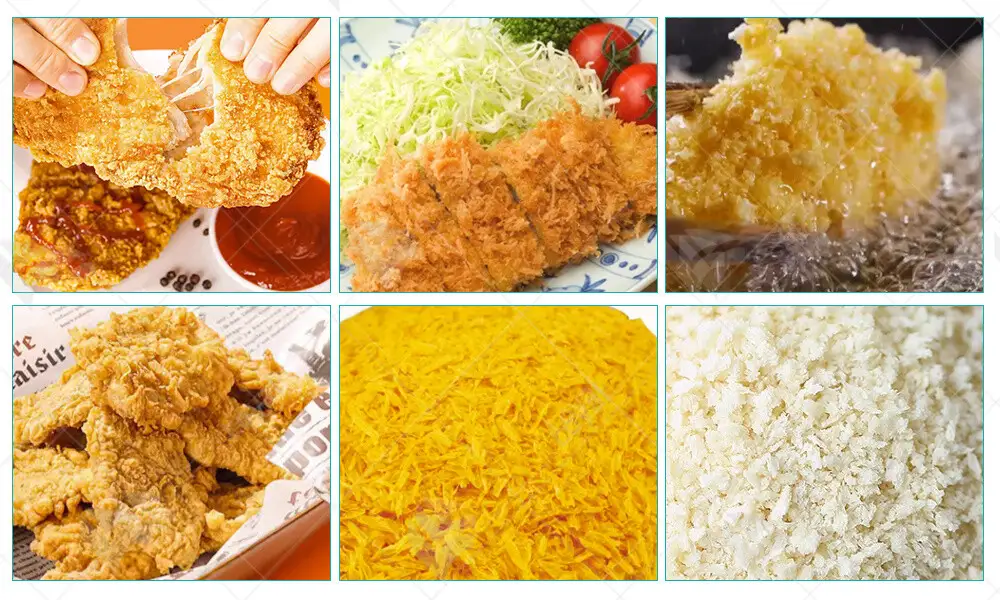
Bread Crumb Production Line Workflow
Bread crumb production line workflow involves several stages to transform raw bread into fine bread crumbs. The process begins with mixing and forming the dough. In this initial step, ingredients are combined in a mixer to create the desired dough consistency. The dough is then formed into specific shapes and sizes, preparing it for the next phase.
The second stage is baking and toasting. The formed dough is baked in industrial ovens at precise temperatures to achieve the correct texture and moisture content. After baking, the bread is toasted to enhance its flavor and ensure it is sufficiently dry for the grinding process. This step is crucial for producing high-quality bread crumbs with consistent texture and flavor.
Next, the product goes through the cooling system. After toasting, the hot bread pieces need to be cooled to room temperature. This is done using industrial cooling conveyors, which ensure the bread crumbs cool evenly and quickly, preventing any potential quality issues caused by uneven cooling.
The final stage in the bread crumb production line is grinding and sieving. The cooled bread pieces are ground into crumbs of varying sizes, depending on the product requirements. This is followed by sieving to separate fine bread crumbs from larger particles, ensuring uniformity in the final product. This workflow ensures efficient and consistent production of high-quality bread crumbs.
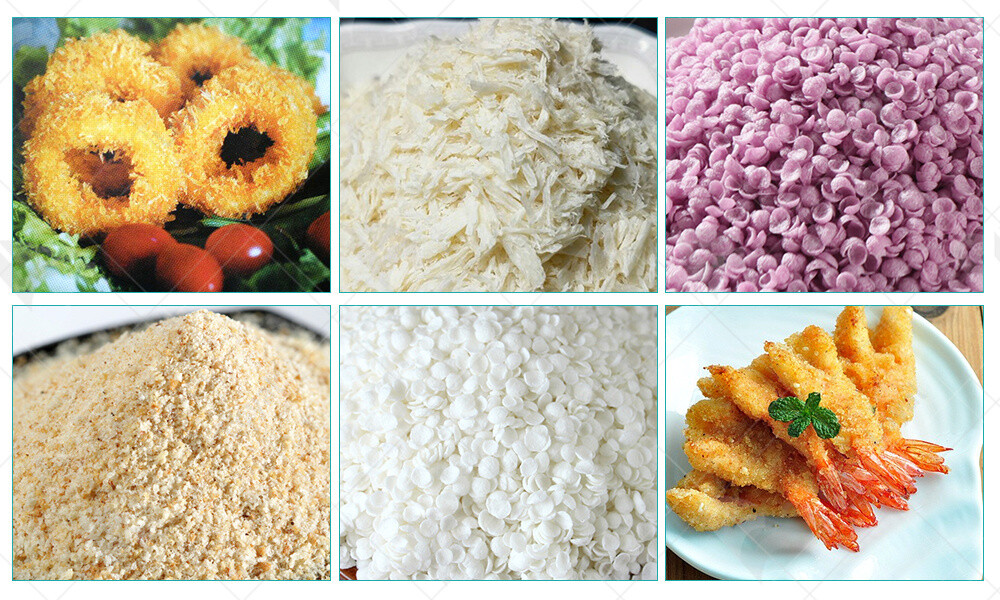
Types of Bread Crumb Production Lines
Type | Description | Key Features | Applications |
| Batch Bread Crumb Production Line | Processes bread crumbs in batches | Flexible production, smaller scale | Small bakeries, specialty food producers |
| Continuous Bread Crumb Production Line | Continuous flow of production | High efficiency, large scale | Large food processing plants, commercial bakeries |
| Semi-Automatic Bread Crumb Production Line | Combination of manual and automated processes | Moderate efficiency, adaptable | Medium-sized bakeries, growing businesses |
| Fully Automatic Bread Crumb Production Line | Fully automated with minimal human intervention | Maximum efficiency, consistent quality | Large-scale industrial food processors, high-demand markets |
This table provides a concise overview of the different types of bread crumb production lines, highlighting their unique features and suitable applications. Understanding these types helps in selecting the right production line based on the scale and specific needs of the operation.

Environmental Impact of Bread Crumb Production
The bread crumb production line can have significant environmental impacts, primarily due to its energy consumption and waste generation. Industrial bread crumb production involves several stages, including mixing, baking, cooling, and grinding, each of which consumes substantial amounts of energy. The use of energy-efficient machinery and sustainable practices can help mitigate this impact.
One of the key environmental concerns is the carbon footprint of the production process. The baking and toasting stages, in particular, are energy-intensive, often relying on fossil fuels. Transitioning to renewable energy sources or improving energy efficiency in these stages can significantly reduce the environmental impact.
Waste management is another critical issue. Bread crumb production can generate considerable food waste, especially during the trimming and grinding stages. Implementing waste reduction strategies, such as using leftover bread from other processes or optimizing trimming procedures, can help minimize this waste. Additionally, recycling waste materials into animal feed or compost can contribute to a more sustainable production line.
Water usage in the bread crumb production line also has environmental implications. The cleaning of equipment and the process of mixing ingredients require significant water resources. Using water-efficient cleaning systems and recycling water within the production process can help conserve this vital resource.
Finally, packaging materials used in the final stages of bread crumb production can impact the environment. Opting for biodegradable or recyclable packaging materials can reduce the environmental footprint of the product. Overall, addressing these environmental aspects through thoughtful design and operation of the bread crumb production line can lead to more sustainable and eco-friendly production practices.
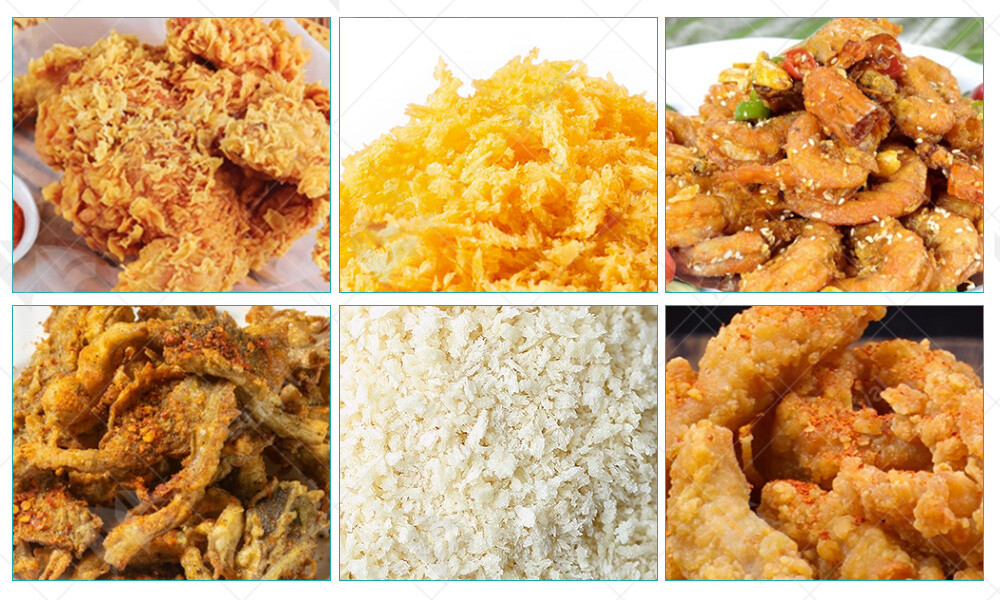
Troubleshooting Common Issues in Bread Crumb Production
Problem | Solution |
| Inconsistent crumb texture | Adjust mixing times and ingredient ratios; ensure uniform baking temperatures. |
| Excessive moisture in final product | Optimize baking and drying times; check cooling system efficiency. |
| Equipment malfunctions | Regular maintenance and timely replacement of worn parts; provide operator training. |
| Product contamination | Implement strict hygiene protocols; conduct regular equipment cleaning and inspections. |
| Low production efficiency | Analyze workflow for bottlenecks; upgrade to more efficient machinery. |
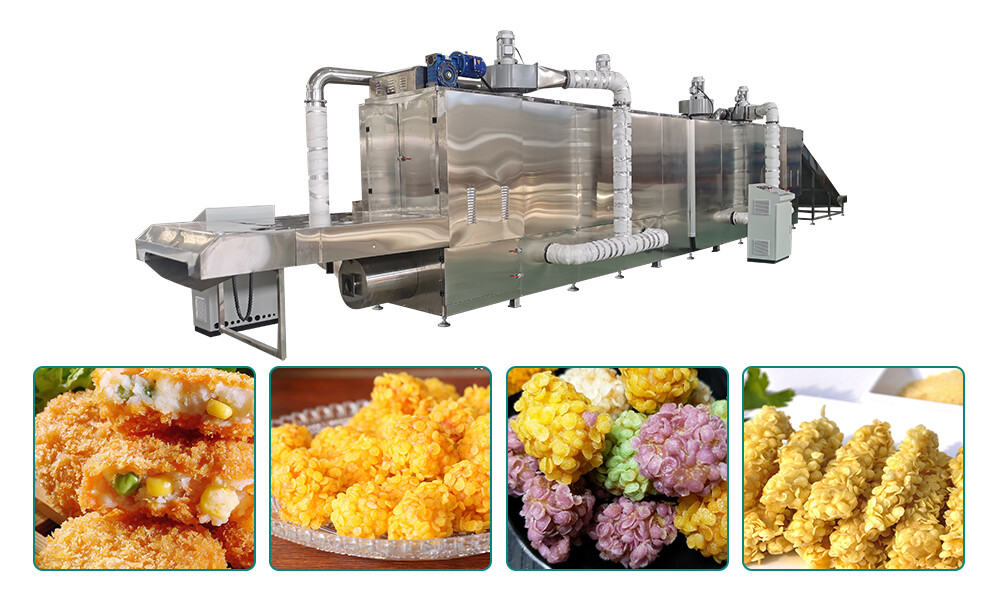
Enhancing Efficiency in Bread Crumb Production
Improving the efficiency of the bread crumb production line is essential for reducing costs and increasing output. One effective method is to invest in high-quality, energy-efficient machinery. Advanced machines with better control systems can ensure more consistent production, reduce downtime, and lower energy consumption.
Streamlining the production workflow is another key factor. By analyzing the production process and identifying bottlenecks, manufacturers can reorganize the workflow to minimize delays. Automation can play a crucial role here, as automated systems can handle repetitive tasks faster and with greater precision than human operators.
Employee training and expertise are also critical. Well-trained staff can operate machinery more effectively, troubleshoot issues quickly, and maintain equipment properly, all of which contribute to a more efficient production line. Regular training sessions and upskilling programs can keep the workforce competent and up-to-date with the latest production techniques and technologies.
Finally, implementing real-time monitoring and data analysis can significantly enhance production efficiency. By tracking key performance indicators (KPIs) such as production speed, energy usage, and waste generation, manufacturers can make informed decisions to optimize the production line. Utilizing data analytics tools can help in predicting maintenance needs, adjusting production parameters, and ultimately achieving a more efficient and reliable bread crumb production line.
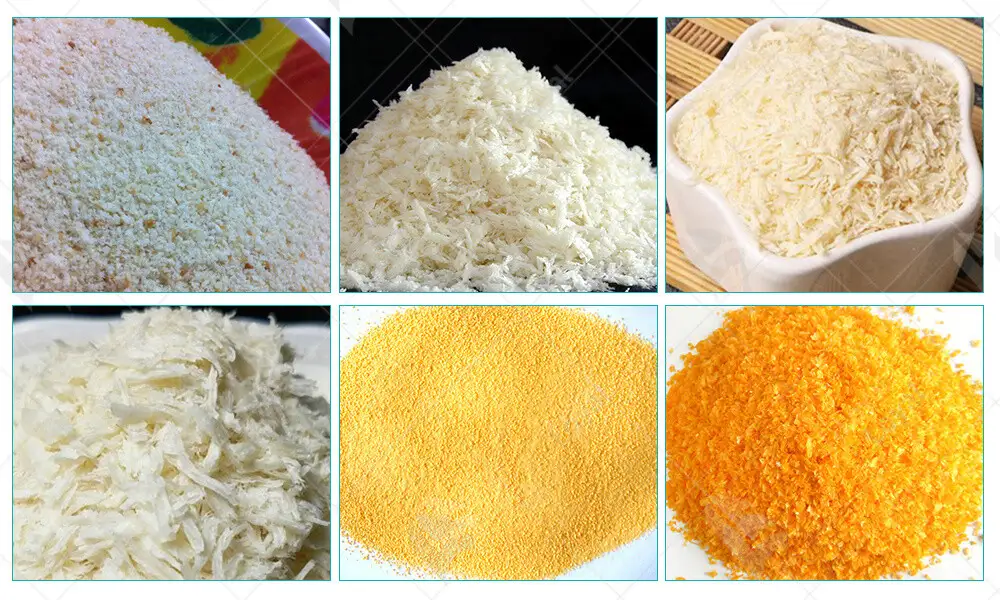
Innovations in Bread Crumb Production Technology
In recent years, bread crumb production lines have seen significant technological advancements. One notable innovation is the introduction of automated systems that streamline the entire production process. These systems integrate various stages, from mixing to packaging, ensuring consistency and reducing manual labor. Automated bread crumb production lines not only increase efficiency but also maintain high quality by minimizing human error.
Another major advancement is the use of energy-efficient ovens and baking equipment. These modern machines consume less energy while providing precise temperature control, which is crucial for producing uniformly toasted bread crumbs. The implementation of energy-efficient technology in bread crumb production not only reduces operational costs but also aligns with environmental sustainability goals.
The development of advanced grinding and sieving machines has also revolutionized the bread crumb industry. These machines are designed to produce bread crumbs of various textures and sizes, catering to different culinary needs. By incorporating adjustable settings, manufacturers can now produce fine, medium, or coarse bread crumbs, enhancing product versatility.
Lastly, the integration of IoT (Internet of Things) technology has brought a new level of control and monitoring to bread crumb production lines. IoT-enabled machines can communicate in real-time, providing valuable data on production metrics, equipment performance, and maintenance needs. This connectivity allows for predictive maintenance and reduces downtime, ensuring continuous and efficient production.

Case Studies of Successful Bread Crumb Production Lines
Several companies have set benchmarks in the industry by implementing state-of-the-art bread crumb production lines. One such case is that of a leading food manufacturer that upgraded its facility with automated production systems. This transition resulted in a 30% increase in production capacity and a significant reduction in labor costs. The consistency in product quality also improved, leading to higher customer satisfaction and market share.
Another success story comes from a mid-sized bakery that focused on energy efficiency. By replacing their old baking equipment with energy-efficient ovens and implementing heat recovery systems, they managed to cut their energy consumption by 25%. The cost savings were substantial, and the company also received positive recognition for its commitment to sustainability.
A small-scale bread crumb producer successfully expanded its market reach by investing in advanced grinding and sieving technology. This enabled the production of a wider range of bread crumb products, from fine to coarse textures. The versatility of their product line attracted new customers in both the foodservice and retail sectors, driving business growth.
Lastly, a multinational food company leveraged IoT technology to enhance its bread crumb production line. By utilizing IoT-enabled machinery, they achieved real-time monitoring and data analysis, which helped in optimizing the production process. Predictive maintenance features reduced downtime, ensuring a smooth and continuous operation. This technological integration not only boosted productivity but also provided valuable insights for further improvements.
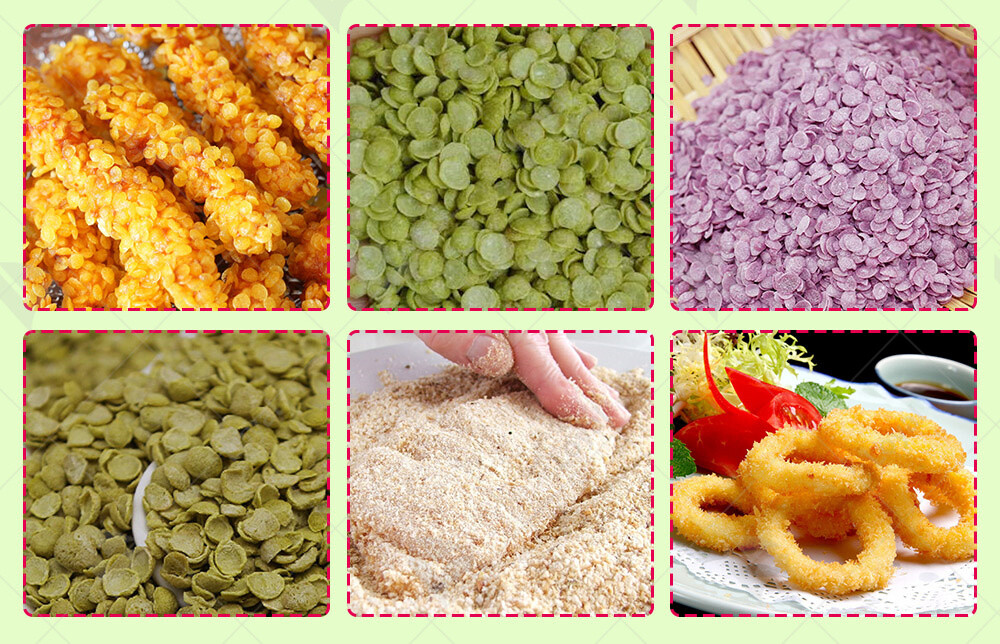
Future Trends in Bread Crumb Production Lines
Looking ahead, the future of bread crumb production lines is poised to be shaped by several emerging trends. One of the most prominent is the continued advancement in automation and robotics. As technology evolves, more sophisticated robots and automated systems will be developed, further enhancing efficiency and reducing the need for manual intervention in the production process. These advancements will streamline operations, lower labor costs, and improve overall productivity.
Sustainability will also play a crucial role in the future of bread crumb production. Companies are increasingly focusing on eco-friendly practices, such as using renewable energy sources and implementing waste reduction strategies. Innovations in packaging materials, like biodegradable and recyclable options, will also gain traction, aligning with global environmental goals. Sustainable practices not only help in reducing the carbon footprint but also appeal to environmentally conscious consumers, thereby enhancing the brand image.
Another trend to watch is the customization of bread crumb products. As consumer preferences become more diverse, manufacturers will need to offer a wider variety of bread crumbs tailored to specific culinary applications. Advanced production lines with flexible settings will enable the creation of unique textures and flavors, catering to niche markets and gourmet applications. Customization can involve different bread types, seasoning blends, and even color variations to meet specific customer demands.
Lastly, the integration of artificial intelligence (AI) and machine learning in bread crumb production lines will revolutionize the industry. AI-driven systems can analyze vast amounts of data to optimize production processes, predict maintenance needs, and enhance product quality. Machine learning algorithms will enable continuous improvement by learning from past production data and making real-time adjustments. This will lead to more efficient operations, reduced waste, and consistent product quality.
These trends indicate a promising future for the bread crumb production line industry, characterized by increased efficiency, sustainability, and innovation. Companies that adopt these emerging technologies and practices will be well-positioned to lead the market and meet the evolving demands of consumers.
Reference
1.Baker Perkins - bakerperkins.com
2.GEA Group - gea.com
3.Heat and Control - heatandcontrol.com
4.Hosokawa Micron - hosokawamicron.com
5.Fritsch Group - fritsch-group.com












